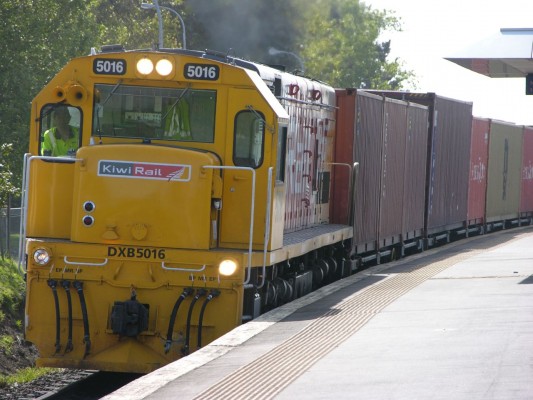KiwiRail Explains Layoffs
KiwiRail’s CEO says purchasing new locomotives, wagons and containers from overseas is critical to KiwiRail improving transit times and reliability, realising productivity gains and growing revenue.
Explaining the layoff of workers from Hillside, CEO Jim Quinn says: “Our Mechanical Business and their work keeps our rolling stock in working order, but it is not able to build this new rolling stock fast enough and at a competitive enough price to meet our current demand.”
He announced late last week plans to make 40 staff redundant out of the total workforce of 172 at Hillside.
“The size of the Hillside workforce has always fluctuated according to the amount of work available and in recent years the workforce increased to build carriages for both Auckland and Wellington metro services. “Unfortunately this work has now been completed and their workload for the remainder of this year is greatly reduced.”
He said the business had been structured to support the ‘retain and refurbish’ needs of the existing, aged rolling stock fleet.
It now had to deliver a service “more focused on preventative maintenance and repair that is delivered closer to where the rolling stock is being used. This will ensure a faster, more efficient maintenance service for our customers.”
Excluding the new DL locomotives and container flat top wagons, the youngest diesel locomotives in the KiwiRail fleet are 30 years old and the average age of wagons is between 25 and 30 years.
Jim Quinn said improving the quality of rolling stock is essential. “We must make these decisions on a commercial basis to contain costs.”
In reaction since the announcement:
- The union said the proposed KiwiRail job losses in Dunedin could have been avoided if the government and KiwiRail had made sure major rail manufacturing projects were carried out by New Zealand rail workers.
- The Greens say “instead of creating jobs in Dunedin and Lower Hutt, KiwiRail is creating jobs in Seoul and Madrid with the full backing of Transport Minister Steven Joyce.
- Labour says “New Zealand’s engineering and manufacturing expertise is being lost. No wonder our economy is stalled, when the government refuses to back New Zealand businesses,”
- And an American rail magnate keen to invest in New Zealand’s rail network says KiwiRail’s decision to spend $500 million on Chinese-built locomotives could have lasting implications for the industry’s economy and skill base. (Otago Daily Times)












6 Comments
Goodbye New Zealand Manufacturing.
People used to go on about a knowlege based economy. What has it gotten us? A load of watered down worthless degrees and graduates so loaded in debt they can never afford to buy a house. All the while we sell companies like PDL (which made world beating electronic drives amongst many other things), 20% of Fisher and Paykel, an innovator in brushless DC motor technology to name only two. Now we are about to sack lads who could be designing and building our new wagon fleet. We had better be selling alot of tarrif free milk powder to China in exchange.
China’s industry doesn’t need protection form New Zealand but New Zealand’s industry does need protection from China.
“Jim Quinn said improving the quality of rolling stock is essential. “We must make these decisions on a commercial basis to contain costs.”
That may even be true from the point of view of a KiwiRail under a minister constantly threatening it with implied closures if it doesn’t shape up.
From the point of view of New Zealand’s society, it makes no sense at all, to buy something overseas that we can produce here, at, at best, slightly higher prices (or could have produced, if KiwiRail / government had decided early on to keep it here - of course NOW when the time is of the essence, one can argue that there isn’t enough time anymore…).
What’s wrong with our government? They are ultimate free-marketeers, that’s what’s wrong with them. They think “the market” is a good thing as of itself, no matter what happens to the rest of the world. They think that opening our doors wide can only be good (for whom?).
One thing that hasn’t been mentioned is the Auckland EMU tender. While we know that they aren’t going to be built here, Kiwirail had requested that the tenderer consider using local workers where possible. I guess this means that the they both said no and that all work would happen in their respective countries.
Though I must admit that this piece from the linked Otago Daily Times is interesting:
“Building locomotives in New Zealand cost 70% more than overseas, while wagons cost 20% more”
Is that true, can anyone comment on that? Also, if it is true, how much of it is BECAUSE we have already lost the skills and manufacturing ability?
Certainly, it would make my point - KiwiRail itself may not actually have had a choice. Government still could have, but KiwiRail may not.
I would have thought that rumors regarding the overhaul/construction of coaches for the Tranz Costal etc would have secured these jobs. Especially given the evident quality of the workmanship that I’ve seen regarding the new coaches being produced for the Tranz Alpine.
Poor management, inefficient work practices, public sector bloat, high levels of overhead and overpaid executives probably 90% explains the considerable cost disadvantage faced by KiwiRail in manufacturing locomotives, wagons, carriages and EMUs.
I have absolutely no doubt these inefficiencies extend to KiwiRail’s freight, passenger and infrastructure “business”. Expect more redundancies as government withdraws the teat!!!!
Perhaps Jim Quinn and his team should resign and let those better suited run KiwiRail? Maybe even the Chinese! LOL If not, taking a pay cut at the very least would be the right thing to do here. It doesn’t sound like anyone deserves a bonus here for this kind of debacle!